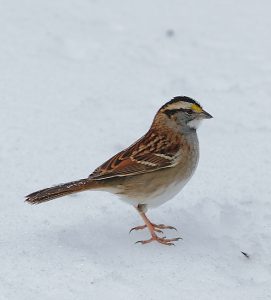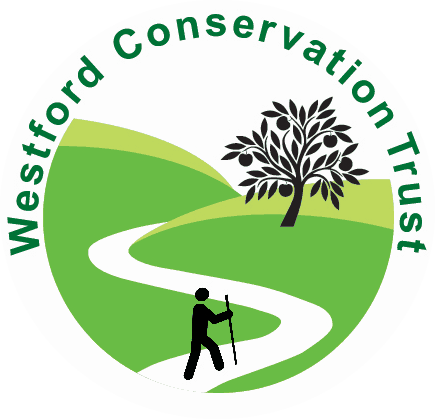
Birders often refer to little brown birds as LBB’s or LBJ’s (“little brown jobs”). They can be extremely confusing to identify, but seeing them at your bird feeder gives you a chance.The LBB’s we most often see at feeders in Westford are the sparrows: Song Sparrows, American Tree Sparrows, and Chipping Sparrows. True sparrows have small, sharply pointed beaks. Another member of the LBB group are two finches: House Sparrows and House Finches. House Sparrows are not really sparrows at all, but finches. They have large thick beaks for crushing seeds.
House Finch females look quite similar to House Sparrow females. Both are brown striped on their backs, are about 6 inches long, and have a stout, curved finch beak. I think the easiest way to distinguish these two birds is to notice that female House Sparrows have clear breasts with no streaking, while female House Finches have blurry gray steaks on the breast and abdomen.
Song Sparrows, present here year round, are our lovely songsters in spring and summer, singing “Sam Peabody, Peabody, Peabody” followed by a warble of descending notes. They are about 6 ” long, and are brown striped all over. Their breast is heavily striped with coarse dark brown markings, which seem to congeal into a central dark spot in the middle of the breast.
Another pair that is difficult to distinguish is the White-throated Sparrow and the White-crowned Sparrow. The White-throated Sparrow, about 6.75 ” long, has a bright white throat patch, white stripes on the side of the head, and a yellow patch above the eye. To make things more difficult, some white-throated sparrows have tan stripes instead of white on the head. In White-crowned Sparrows, about 7 ” long, the head is boldly white and black striped, but the throat is light gray, and there is no yellow patch over the eye. Both species have clear breasts. Males and females are alike in both species; juveniles are duller all over.
American Tree Sparrows, seen here in the winter, are relatively easy to distinguish from the above. They have a rusty red cap, with a black spot in the center of their clear breast. Males and females look alike. Chipping sparrows, 5.5 ” long, seen here in the summer only, also have red caps. They have a clear breast with no central dark spot, white stripes on the head and a white throat.
If you’d like to learn more about sparrows, Cornell Lab of Ornithology is offering a course on identifying the 49 sparrow species of North America. The course is called Bird Academy, and can be accessed through the Lab’s website. To make a good start, you can get out your binoculars and work on the sparrows at your own feeder.
Many thanks to all flora and fauna reporters for the month of February. Please send reports by March 26, to appear in next month’s column. You can call me at 692-3907, e-mail me at mariancharman@gmail.com, or write me at 7A Old Colony Drive.
————————-
Late December and January Reports:
Tim Spera, December 23, at Coldspring Rd. six eastern bluebirds feeding on small fruit on climbing vines, “actually hovering and plucking the berries to avoid the thorns.” On Stony Brook at Town Farm Rd. fifteen American black ducks. At intersection of Concord Road and Abbott Street, bald eagle circling overhead, “Its white head, white tail feathers, and black body were very apparent…. I always enjoy your articles and reports”[Thank you, Tim! MH]
Nancy Eberiel, at East Boston Camps, January 23, sent photos of two swans on Stony Brook.
Marian/Bill Harman, Old Colony Drive. January 26, thirty degrees. A walk to the beaver dam–wore my gray hood again, but this time the jays ignored me; they’re quick learners. Fifteen mourning doves took off out of the swamp, a pileated woodpecker flying tree to tree, busy finding food. Keyes Pond cracking and booming, but two ice fishermen out there anyway. Rattlesnake plantain is still green in the woods. A flock of robins were in the crab apple trees in Meadowbrook farm field.
Esther Donlon, January 31, Providence Rd. I got some nice daytime pictures of a bobcat in the yard [Esther sent some great photos-MH]
Rosemarie Koester, Providence Rd. January 27, tufted titmice, chickadees, two pairs of cardinals, lots of goldfinches, purple finch and house finch. Two pair of blue jays, downy woodpecker male and female, juncos still here, two red-winged blackbirds (one juvenile male and one female), hawk overhead, one Carolina wren, squirrels, a few turkeys, prints in the snow of deer, coyote, rabbits.
Kate Hollister, Vine Brook Rd. January bird feeder report: chickadees, crows, blue jays, downy, hairy and red-breasted woodpeckers, nuthatches, juncos, cardinals, gray squirrels. Heard barred owls calling one another.
February Reports:
Laurel Martin, Woodbury Drive, Feb. 1, my husband, David, and I heard and saw a pileated woodpecker on the trail in the woods behind Woodbury Drive. A red-bellied woodpecker visited the suet feeder [Laurel sent some good photos-MH] Feb. 19, “our usual visitors were very busy at the feeder, lots of chickadees, tufted titmice, juncos, nuthatches, downy and hairy woodpeckers, Carolina wrens, and a magnificent red-bellied woodpecker.” About a week ago, a female bluebird came, and two days later arrived with her mate. The next day they arrived with what appeared to be two juveniles, who fluttered around and ate a bit at the suet feeder. Today, with the gentle snow falling all four of them spent the entire afternoon perching and feeding, and keeping me entertained…. Thank God for birds. They have really kept me cheered during the pandemic!!” [Lauren sent photos of the bluebirds-MH]
Marilyn Day, Graniteville Rd. Feb. 3, heard and saw a robin in the crab apple. “A nice way to celebrate my daughter’s birthday.”
Marian/Bill Harman, Old Colony Dr. Feb. 7, twenty-six degrees and snowing. At feeder, three American tree sparrow, two white-throated sparrows, seven juncos, one red-bellied woodpecker male, tree cardinals, three blue jays, ten American goldfinches, two titmice, three chickadees, one downy woodpecker male, one song sparrow, one male house finch. February 22-, a walk from Beacon St. to the electric line and Stony Brook. On pond, saw one common merganser, three mallards, a pair of black ducks, keeping their distance from the mallards, and seven Canada geese. A pair of ravens circling over the electric line and uttering a loud, harsh “Oink” sound–sounded like flying pigs!
June Kennedy, Old Lowell Rd. Feb.10, six bluebirds and one cardinal at feeder.
Nancy Eberiel, Depot St. Feb. 12, “Heard a loud thump on one of my windows….on investigation, it happened again–red tailed hawk collided with the window, and flew over the porch. Feb. 13, yesterday the hawk hit the kitchen window. I think it may have been carrying an animal, as a deposit of fur is evident on the window.” “The ravens are visiting and a pileated woodpecker was in the backyard. Meanwhile a Carolina wren is singing vigorously. Harbingers of spring?”
Tom Ennis, at the DeSilva land. February 20, “the first objective evidence I have of an otter in the area. No other animal that I know of makes an amusement park of the slightest decline, but any spot on the trail there was a dip it slid on its belly.” [Tom sent photos of the otter slides–looks like it had fun! MH]
Barbara Theriault, Tadmuck Lane. Feb. 22, “today we watched 23 full-size turkeys in our yard focused on a small patch of grass.”
Emily Teller, Texas Rd. February 20, pileated woodpecker at the sunflower seed feeder. A red-bellied woodpecker picking at seed, and a mourning dove. At 7:30 a.m., a buck was taking seed from the feeder. Jackson Teller saw six deer at 5 p.m.
Leslie Thomas, Old Colony Drive. Report of a full-size buck that came across the field on Rt. 40, going into the Wright Cemetery.
Marian Harman is a member of the Westford Conservation Trust, a non-profit conservation organization whose mission is the preservation of Westford’s trails and open spaces. The Trust welcomes new members and volunteers. Check out the Trust’s website at westfordconservationtrust.org, and visit us on Facebook.
